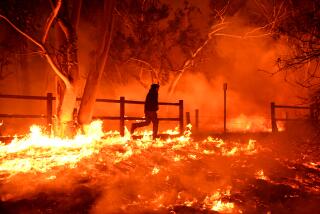Utilities Expect to Lose Heavily
- Share via
The unrelenting wildfires are taking a still-unknown financial toll on the energy and telecommunication utilities that serve the ravaged areas, principally Southern California Edison Co., San Diego Gas & Electric Co., Verizon Communications and SBC Communications Inc.
The companies aren’t ready to put a price tag on their losses, which will be paid by their ratepayers. But the major utilities suspect the total will be hefty. They figure that as of Thursday, thousands of electricity and telephone poles had burned and hundreds of miles of wire had melted. Meanwhile, thousands of employees have been working around the clock to restore service to hundreds of thousands of customers from Ventura County to the Mexican border.
Then there is tiny Bear Valley Electric Service, which provides power to 22,000 residential and business customers in the Big Bear area, located just northeast of mountain resort communities devastated by the inferno.
The 82-year-old utility, part of San Dimas-based American States Water Co., has lost no equipment to the flames. A trick of the wind could determine its future.
“If the fire comes into this valley, it could wipe us out,” said Roger Kropke, Bear Valley Electric vice president, who on Thursday gazed with relief out his office at clouds gray with rain, not smoke. “Nobody wants to say that it’s a good day because this fire is so unpredictable. When they make a prediction, it goes the other way.”
Despite a mandatory evacuation order, 12 of Bear Valley’s 31 employees have remained to keep the system running and assist firefighters.
“It takes a special worker to send his family away and stay behind,” Kropke said.
Bear Valley Electric is dwarfed by the likes of Edison, SDG&E;, Verizon and SBC. The performance of all drew praise Thursday from state regulators.
“We spend a lot of time taking on the utilities, and sometimes it seems like we’re punitive,” Geoffrey Brown, a member of the Public Utilities Commission, said during an agency meeting in San Francisco. “But in these natural disasters ... the utility workers really rose to the occasion, and they showed tremendous courage and dedication.”
Executives at local utilities described workers laboring alongside firefighters to de-energize threatened utility lines, shut off natural gas leaks or restore emergency communications systems. Edison took the unusual step of turning off power to some communities that were vulnerable; they ultimately were spared any damage.
“This is very dangerous work,” said Debra L. Reed, president of SDG&E; and Southern California Gas Co., both subsidiaries of Sempra Energy of San Diego.
SDG&E; and Edison each have more than 1,000 employees assessing damage and making repairs. SBC has more than 3,000 technicians working to fix its system -- in one case, making a repair so quickly that when one of the San Diego fires doubled back on itself Monday night it burned more than 1,000 feet of cable laid earlier in the day, spokesman John Britton said.
Although there was damage to utility equipment, primarily poles and wires, the fires have not destroyed any crucial pieces of the power or telecommunications systems, such as major transmission lines and electric substations, utilities said.
Given the unprecedented scope of the fires, the costs are expected to be high. Besides paying for repairs and overtime, Verizon and SBC are giving displaced customers free call-forwarding and voice messaging, and Edison is not charging ratepayers whose homes were badly damaged or destroyed for power use since their last bill.
Edison said that 261,000 customers lost power during the fires and that 28,000 of its 4.5 million customers were still without electricity Thursday afternoon. SDG&E; said more than 100,000 customers in all lost power, with 22,000 of its 1.3 million customers still in the dark Thursday.
Historically, the PUC has allowed utilities to track costs from a natural disaster in a special account called a “catastrophic event memorandum account,” said Akbar Jazayeri, Edison director of revenue and tariffs. After a review to determine that the expenses were reasonable and related to the disaster, the utility is allowed to recover the costs in rates over several years, he said.
Reed said the Sempra utilities were assessing damage. “It’s better today, but fires are still burning,” she said, adding that the utilities hope to fix things in a week that usually take a month to repair.
More to Read
Sign up for Essential California
The most important California stories and recommendations in your inbox every morning.
You may occasionally receive promotional content from the Los Angeles Times.










